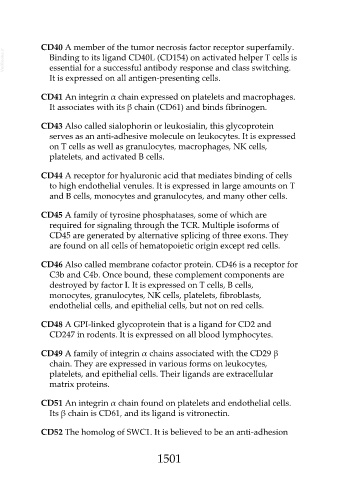Page 1501 - Veterinary Immunology, 10th Edition
P. 1501
CD40 A member of the tumor necrosis factor receptor superfamily.
VetBooks.ir Binding to its ligand CD40L (CD154) on activated helper T cells is
essential for a successful antibody response and class switching.
It is expressed on all antigen-presenting cells.
CD41 An integrin α chain expressed on platelets and macrophages.
It associates with its β chain (CD61) and binds fibrinogen.
CD43 Also called sialophorin or leukosialin, this glycoprotein
serves as an anti-adhesive molecule on leukocytes. It is expressed
on T cells as well as granulocytes, macrophages, NK cells,
platelets, and activated B cells.
CD44 A receptor for hyaluronic acid that mediates binding of cells
to high endothelial venules. It is expressed in large amounts on T
and B cells, monocytes and granulocytes, and many other cells.
CD45 A family of tyrosine phosphatases, some of which are
required for signaling through the TCR. Multiple isoforms of
CD45 are generated by alternative splicing of three exons. They
are found on all cells of hematopoietic origin except red cells.
CD46 Also called membrane cofactor protein. CD46 is a receptor for
C3b and C4b. Once bound, these complement components are
destroyed by factor I. It is expressed on T cells, B cells,
monocytes, granulocytes, NK cells, platelets, fibroblasts,
endothelial cells, and epithelial cells, but not on red cells.
CD48 A GPI-linked glycoprotein that is a ligand for CD2 and
CD247 in rodents. It is expressed on all blood lymphocytes.
CD49 A family of integrin α chains associated with the CD29 β
chain. They are expressed in various forms on leukocytes,
platelets, and epithelial cells. Their ligands are extracellular
matrix proteins.
CD51 An integrin α chain found on platelets and endothelial cells.
Its β chain is CD61, and its ligand is vitronectin.
CD52 The homolog of SWC1. It is believed to be an anti-adhesion
1501

